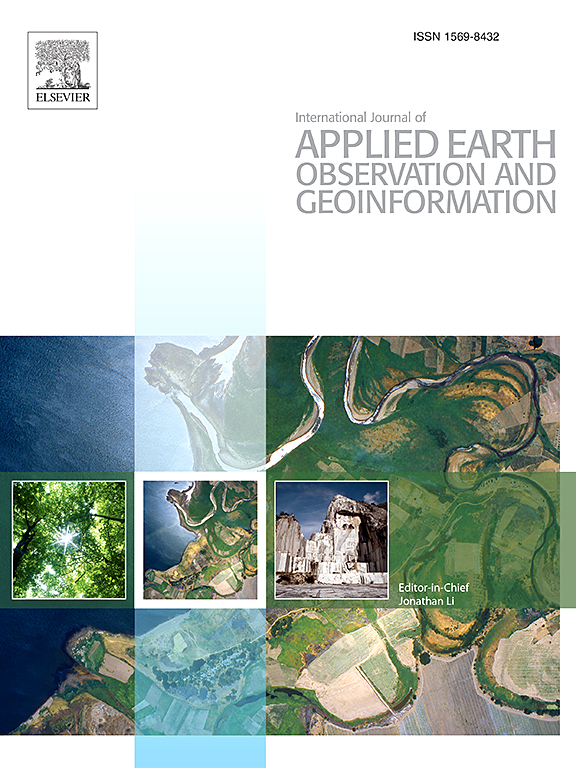Harnessing deep learning and CRF for prior-knowledge modeling of crop dynamics
IF 7.6
Q1 REMOTE SENSING
International journal of applied earth observation and geoinformation : ITC journal
Pub Date : 2025-06-19
DOI:10.1016/j.jag.2025.104616
引用次数: 0
Abstract
Remote sensing has revolutionized crop mapping and monitoring, providing valuable insights for sustainable agricultural practices. However, successfully implementing remote sensing-based crop type identification in tropical regions remains challenging. Unlike temperate regions, tropical areas benefit from favorable weather conditions that support diverse land management practices, resulting in complex crop dynamics that are difficult to model. Additionally, frequent cloud cover in tropical regions limits the use of optical data during extended periods of the year, making SAR (Synthetic Aperture Radar) a more attractive alternative. Traditional models like Conditional Random Fields (CRFs) have been useful in classifying crop types using spatial and temporal contexts. However, these models often use fixed inputs, optimizing them towards a specific task, and fail to consider the CRFs’ feedback for end-to-end learning features and the spatiotemporal dependencies. This work addresses this gap by introducing an end-to-end hybrid model that combines deep learning with CRFs to incorporate prior knowledge-based modeling of crop dynamics. The proposed framework integrates a backbone encoder–decoder to capture spatial and temporal contexts, with a CRF block that models temporal dynamics by accounting for label dependencies between adjacent epochs. This block facilitates the integration of both data-driven and expert-domain temporal constraints, allowing the framework to adapt to local agricultural practices and enhance crop dynamics modeling. We evaluate the framework using multi-temporal SAR image sequences from two municipalities in Brazil, comparing the effectiveness of learned versus prior-knowledge temporal constraints. The results show improvements of up to 30% in per-class F1 score and 12% in average F1 score compared to a baseline model that excludes temporal dependencies. These findings highlight the value of incorporating prior knowledge-driven temporal constraints into crop mapping models.
利用深度学习和CRF对作物动力学进行先验知识建模
遥感技术革新了作物测绘和监测,为可持续农业实践提供了宝贵的见解。然而,在热带地区成功实施基于遥感的作物类型识别仍然具有挑战性。与温带地区不同,热带地区受益于有利的天气条件,支持多样化的土地管理做法,导致作物动态复杂,难以建模。此外,热带地区频繁的云层覆盖限制了光学数据在一年中较长时间的使用,这使得合成孔径雷达(SAR)成为一个更有吸引力的选择。像条件随机场(CRFs)这样的传统模型在利用空间和时间背景对作物类型进行分类时非常有用。然而,这些模型通常使用固定输入,针对特定任务进行优化,并且没有考虑crf对端到端学习特征和时空依赖性的反馈。这项工作通过引入端到端混合模型来解决这一差距,该模型将深度学习与CRFs相结合,以整合基于先验知识的作物动态建模。所提出的框架集成了一个主干编码器-解码器来捕获空间和时间上下文,以及一个通过考虑相邻时代之间的标签依赖关系来建模时间动态的CRF块。该块促进了数据驱动和专家领域时间约束的集成,使框架能够适应当地农业实践并增强作物动态建模。我们使用来自巴西两个城市的多时相SAR图像序列来评估该框架,比较了学习时间约束与先验知识时间约束的有效性。结果显示,与排除时间依赖性的基线模型相比,每个类别的F1分数提高了30%,平均F1分数提高了12%。这些发现突出了将先验知识驱动的时间约束纳入作物制图模型的价值。
本文章由计算机程序翻译,如有差异,请以英文原文为准。
求助全文
约1分钟内获得全文
求助全文
来源期刊

International journal of applied earth observation and geoinformation : ITC journal
Global and Planetary Change, Management, Monitoring, Policy and Law, Earth-Surface Processes, Computers in Earth Sciences
CiteScore
12.00
自引率
0.00%
发文量
0
审稿时长
77 days
期刊介绍:
The International Journal of Applied Earth Observation and Geoinformation publishes original papers that utilize earth observation data for natural resource and environmental inventory and management. These data primarily originate from remote sensing platforms, including satellites and aircraft, supplemented by surface and subsurface measurements. Addressing natural resources such as forests, agricultural land, soils, and water, as well as environmental concerns like biodiversity, land degradation, and hazards, the journal explores conceptual and data-driven approaches. It covers geoinformation themes like capturing, databasing, visualization, interpretation, data quality, and spatial uncertainty.
 求助内容:
求助内容: 应助结果提醒方式:
应助结果提醒方式:


